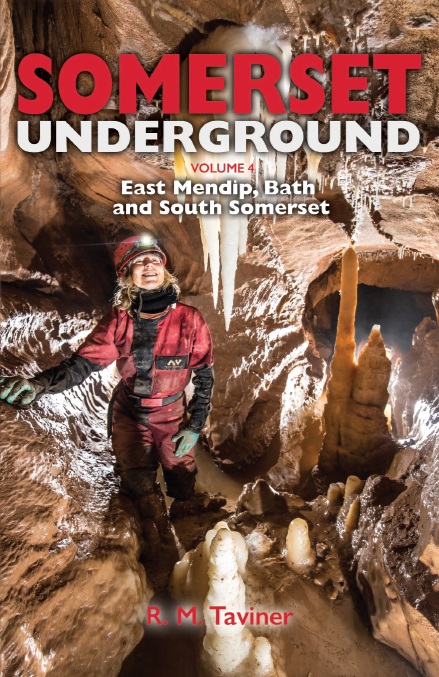
This is the fourth and final volume of a set covering the caves, mines and associated features of the county of Somerset. Volume 1 was published in 2020 and features Bristol, Broadfield Down, the Bristol Channel and West Somerset. Volume 2, also published in 2020, features sites in West Mendip, Burrington and North Mendip. Volume 3 was published in 2022, features the sites of Central and South Mendip and was reviewed here.
Volume 4 describes caves, mines and other related features in East Mendip, Bath, and South Somerset.
As is the case with the previous volumes, the new volume has a hardy plastic dust cover as the book is designed for regular and frequent use in the field. The compact format lends itself to the same purpose, easily fitting into a coat pocket. Mendip cavers old enough to remember the earlier editions of Mendip Underground will be familiar with the size.
Continuing the approach of the first three volumes of Somerset Underground, the fourth volume comprehensively catalogues many minor sites that can still be visited and many that cannot due to blockage or development, as well as the better known caves and mines in the relevant area. As might be expected for a book covering a number of areas away from the classic Mendip caving area, there is a slightly greater preponderance, compared with the previous volumes, on sinks, springs, seepages and other surface features.
A foreword by Rob Taviner describes the journey he has taken from inception of this project through to its completion, and some of the methodology he adopted in the course of the work. There is a short introductory section covering the history of cave exploration in the area, geology and geomorphology, archaeology and palaeontology, site access, and water as a local resource that must be protected. There are also sections covering the history of cave exploration and local clubs, and on the story of Bath freestone quarrying and fullers earth mining in this area. Finally, there is a reminder that the work of cataloguing caves and underground spaces is never complete, and any volume, no matter how detailed, must be selective in what is included and what is left out.
The main part of the book is divided into the five regions East Mendip (North), East Mendip (South), Bath, Chew Valley and Somerset Coalfield, and South Somerset. Each of these regions are further subdivided by localities where caves, mines and tunnels can be found. The sites themselves are listed geographically, and it is essential to refer to the book index in order to find the description of any particular cave you are interested in. Most, if not all, sites are identified on a number of maps throughout the book, which is a very useful tool for seeing the sites in their local context.
The first and second sections of volume 4, covering East Mendip, comprise more than half of the entire volume, containing as they do the classic caves at Fairy Cave Quarry, and other nearby systems such as Stoke Lane Slocker, Thrupe Lane Swallet, and associated sinks and risings. The Bath section includes, naturally, the famous hot springs as well as many other wells and springs in the city. The Bath freestone workings of the area are described, but the extensive similar workings at Box and Corsham lie outside the remit of this book, located as they are in Wiltshire. The remaining two short sections on Chew Valley and Somerset Coalfield, and South Somerset, bring this four volume survey of underground Somerset to a conclusion, and list a number of springs, wells and mines in those areas.
Each site is listed with its name, location by grid reference (where known), length, vertical range and altitude, and categorisation as a cave, mine, spring and so on. A number of recorded sites that are now ‘lost’ are also included, as well as a number of formerly ‘lost’ sites which have more recently been found again. The site descriptions are usually fairly brief, which is only to be expected in a book covering so many caves and mines. Where further details can be found elsewhere, the site description concludes with a reference or two to where this information may be located.
The book, like the previous volumes, is well illustrated with a number of good-quality colour photographs and maps. The book concludes with six appendices: information about MCRA, guidelines on cave conservation, safety advice when visiting caves, cave rescue, caving organisations and a list of references for further reading.
These volumes are a very welcome return to the concept of a compact regional cave guidebook, and Rob Taviner is to be congratulated for his excellent work. Copies may be purchased from the Mendip Cave Registry and Archive. We thoroughly recommend this and the other three volumes of Somerset Underground to any caver who wants to learn more about the area.
Reviewed by Peter Burgess
Somerset Underground Volume 4: East Mendip, Bath and South Somerset
RM Taviner
Published: Mendip Cave Registry and Archive (2024)
ISBN 978-1-913271-04-6
283pp
